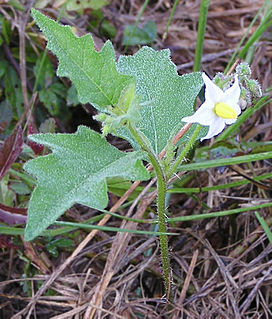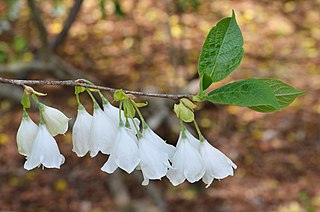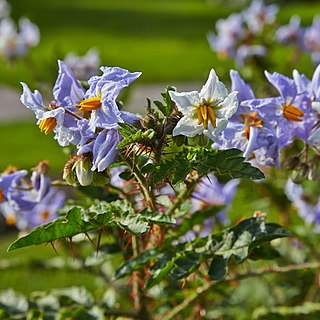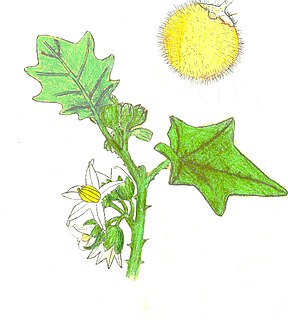
Solanum is a large and diverse genus of flowering plants, which include three food crops of high economic importance, the potato, the tomato and the eggplant. It also contains the nightshades and horse nettles, as well as numerous plants cultivated for their ornamental flowers and fruit.

Solanum carolinense, the Carolina horsenettle, is not a true nettle, but a member of the Solanaceae, or nightshade family. It is a perennial herbaceous plant, native to the southeastern United States that has spread widely throughout much of temperate North America. It has also been found in parts of Europe, Asia, and Australia. The stem and undersides of larger leaf veins are covered with spines.

Solanum americanum, commonly known as American black nightshade, small-flowered nightshade or glossy nightshade is a herbaceous flowering plant of wide though uncertain native range. The certain native range encompasses the tropics and subtropics of the Americas, Melanesia, New Guinea, and Australia.

Solanum ptychanthum, the West Indian nightshade or eastern black nightshade, is an annual or occasionally perennial plant in the Solanaceae (Nightshade) family. It is typically 15–60 cm tall and many branched.

Physocarpus, commonly called ninebark, is a genus of flowering plants in the family Rosaceae, native to North America and northeastern Asia.

Solanum elaeagnifolium, the silverleaf nightshade or silver-leaved nightshade, is a common native plant to parts of the sw USA, and sometimes weed of western North America and also found in South America. Other common names include prairie berry, silverleaf nettle, white horsenettle or silver nightshade. In South Africa it is known as silver-leaf bitter-apple or satansbos. More ambiguous names include "bull-nettle", "horsenettle" and the Spanish "trompillo". The plant is also endemic to the Middle East.

Halesia tetraptera, commonly known as the common silverbell or mountain silverbell, is a species in the family Styracaceae, native to the southeastern United States. It is cultivated as an ornamental tree.

Solanum sisymbriifolium is commonly known as vila-vila, sticky nightshade, red buffalo-bur, the fire-and-ice plant, litchi tomato, or Morelle de Balbis.

Symphyotrichum novi-belgii, the New York aster, is a species of flowering plant. It is the type species for Symphyotrichum, a genus of the family Asteraceae, whose species were once considered to be part of the genus Aster. Plants in both these genera are popularly known as "Michaelmas daisy" because they bloom around September 29, St. Michael’s Day.

Grabowskia is a genus of flowering plants in the nightshade family, Solanaceae.

Solanum retroflexum, commonly known as wonderberry or sunberry, is a historic heirloom fruiting shrub. Both common names are also used for the European black nightshade in some places, particularly where the latter species has been introduced, so care must be taken to distinguish them. It is sometimes called garden huckleberry, but that properly refers to the S. scabrum described by Philip Miller.

Solanum citrullifolium is a species of flowering plant in the Solanaceae family. It is a nightshade referred to by the common name watermelon nightshade, as its leaves somewhat resemble those of a watermelon plant. It is a white-stemmed shrub with purple star-shaped flowers. It is native to the southern United States and it is grown in home gardens as an ornamental plant.

Solanum physalifolium, known as hoe nightshade, Argentine nightshade, green nightshade and hairy nightshade, is a species in the family Solanaceae. Native to Argentina, Bolivia and Chile, it is widely naturalized in Australia, New Zealand, Europe, western Canada and the north western United States. Solanum physalifolium has been widely but incorrectly known as Solanum sarrachoides, a different species. It has been listed as a noxious weed in the US states of Kansas and Michigan under this misapplied name.

Solanum rostratum is a species of nightshade that is native to the United States and northern and central Mexico. Common names include buffalobur nightshade, buffalo-bur, spiny nightshade, Colorado bur, Kansas thistle, bad woman, Mexican thistle, and Texas thistle.

Solanum lasiocarpum, synonym Solanum feroxL., otherwise known as Indian nightshade or hairy-fruited eggplant, is a plant that produces edible fruit. Its flowers are white and its fruits are pale yellow.

Solanum triflorum is a species of nightshade known by the common names cutleaf nightshade and small nightshade. It is native to Argentina, but it is known on other continents, including Europe and Australia, as an introduced species and sometimes a weed. It is present throughout much of North America, where it is possibly non-native as well. It grows in many types of habitat, including disturbed areas. It is an annual herb producing spreading, decumbent stems up one meter long. It is hairy, the hairs sometimes associated with glands. The leaves are a few centimeters long and are deeply cut into toothlike lobes. The inflorescence bears two or three flowers each just under a centimeter wide when fully open. The flower is usually white, but is occasionally purple-tinged. The fruit is a berry roughly a centimeter wide.
Solanum caripense is a species of evergreen shrub native to South America and grown for its edible fruit.

Solanum diphyllum, commonly known as the twoleaf nightshade, is a species of nightshade native to the Americas. It is cultivated as an ornamental plant for its clusters of dark green round fruits that turn a bright yellow when ripe.
Solanum clokeyi, known as Clokey's nightshade, Island nightshade, or Santa Cruz Island nightshade, is a species of flowering plant in the nightshade family endemic to California, United States. It occurs in southeastern California, including the Channel Islands and Santa Catalina Island. The name honors American botanist Ira Waddell Clokey. It is sometimes treated as a synonym or variety of Solanum wallacei.

















